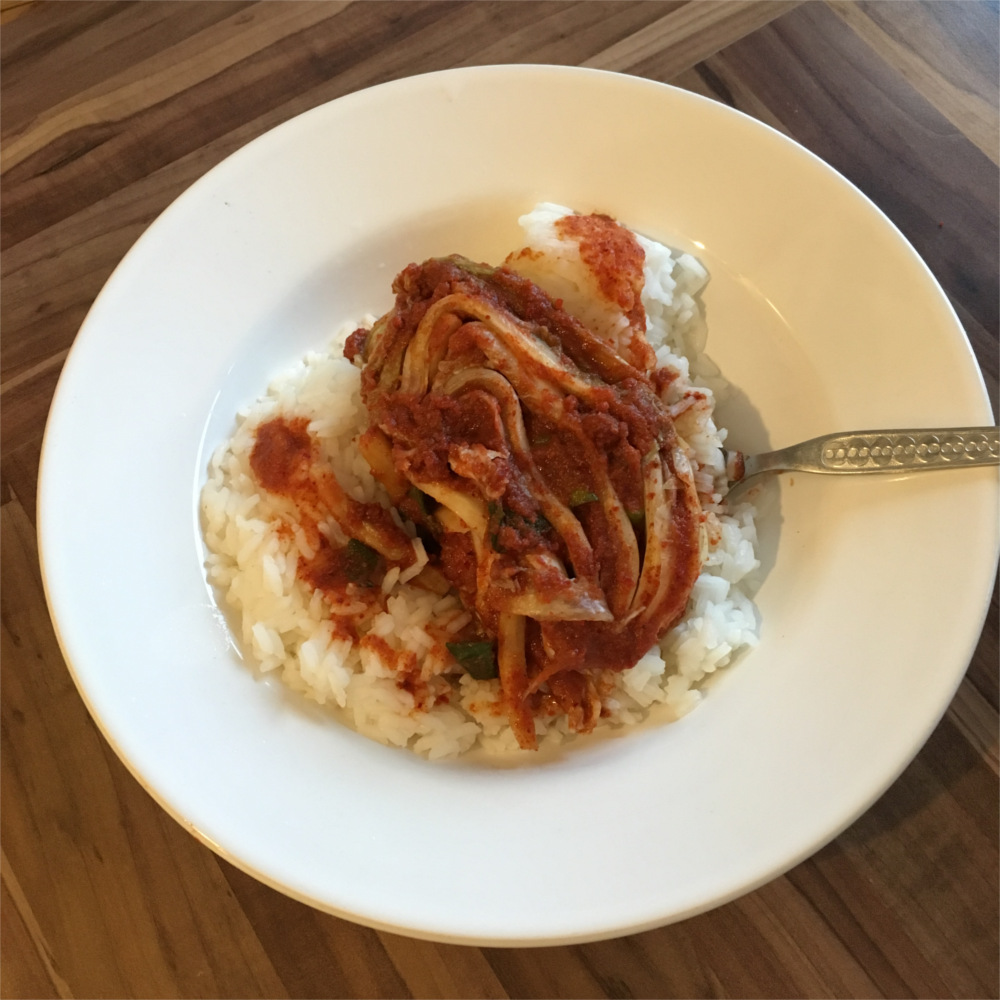Kimchi – Recipe for the Other Pickled Cabbage
If you make some kimchi, you’ll be my hero.” The gauntlet was thrown, and I was left trying to figure out how to make a traditional Korean condiment of fermented cabbage. I easily found many websites touting the best recipes, but I was quickly overwhelmed with the ingredient list – not because it was lengthy, but rather because I had never used some of these ingredients before. I decided to go with the instructions laid out by Maangchi and was off to a local Asian market to grab what I could before going to the large grocer.
About five minutes after picking through the shelves in the small Asian market – looking at packaging in Asian characters with stickers translating it to German while comparing it to my English shopping list – the cashier offered her help. I started by asking about the ingredients I was sure to not be able to find in the local chain. After a couple failed attempts at describing what “fermented shrimp” may be, I confided in her that I was attempting to make Kimchi. Hearing this, she knew exactly what I needed.
She started rattling off the ingredients necessary as well as pointing out that some things on my list were not “optional” as I was led to believe. I had hoped to get by with normal wheat flour; she was adamant that rice flour was a must (I can now confirm that this is true). She also gave a brief rundown of how she makes it. Thanking her for her help, I grabbed a couple of the suggested items and visited the chain grocer where I found half of what I needed. (Still no fermented shrimp to be found.)
Thinking how stupid it would be to try to follow a recipe from this online source when I have a local resource, I headed back to the market and literally let her pick through everything I had purchased and asked for her advice on what else I needed. We grabbed a couple extra ingredients, and she even walked me through some processing that was overlooked in online videos. Now confident, I headed back home to begin salting my cabbage (that is not a double entendre).
My Hybrid Kimchi Recipe
For salting cabbage:
- 3 kg (or 6.6 lbs) of Napa cabbage
- 1/2 cup of salt
For making porridge:
- 2 cups water
- 3 heaped tablespoons glutinous rice flour1
- 2 tablespoons white sugar
Vegetables:2
- 2 cups radish3 matchsticks
- 1 cup carrot matchsticks
- 7 to 8 green onions, chopped4
Puree:
- ½ cup garlic cloves (24 garlic cloves) [3 bulbs], minced
- 2 teaspoon ginger, minced
- 1 medium onion, minced
- 2 medium apples
- 2 medium pears
- (the white part of the green onions)
Seasonings and Spices:
- 2 cups hot pepper flakes
- ½ cup fish sauce
1The market lady suggested using even more than this
2In hindsight, I would not worry about actual measurements; acknowledge the proportions and use what you have
3I am still trying to figure out what a “Garden Radish” is; it was called “Rettich” in German – it is not a salad radish
4Use only the green part whole; the white part should be pureed with the others
Processing:
As Maangchi’s video expertly demonstrates, the cabbage is halved, washed, then salted, and flipped for two hours until the cabbage is flexible. The cabbage is then washed again to remove excess salt, while still retaining enough salt for the final product. During the 30-minute periods between flipping the cabbage, I prepared the vegetables and created the puree. After the washing the cabbage post the two hour brining, I mixed the puree, chopped vegetables, and seasoning and spices while the cabbage thoroughly drained.
Quartering the cabbage and chopping off the remaining stem (if applicable), I set up my counter to spread the sauce between the leaves. I had truly believed that including the pears and apples gave me too much sauce. This was not the case: I had the perfect amount.
Unfortunately, I didn’t have enough storage for all the kimchi; so as was suggested in the videos, I ate the remaining quarter of salted, unfermented cabbage immediately. It was quite spicy, but delicious.
I let the kimchi sit at room temperature for over a day before storing it in the fridge. It has now been aging for a week, and it is still healthily fermenting. It ended up being a lot of food, so I am sure that I’ll be enjoying it as it continues to sour over time. Cooking some rice and adding some cold kimchi has become an incredibly easy, extremely delicious and oddly healthy dinner.
Quick insights on cost: the most expensive ingredient ended up being the red pepper flakes, coming in at €8 – however, I used only a third of that. The ingredients in total ran about €20, which was extremely reasonable.









Okay, I have to try that as well: If you make some Freiberger Eierschecke, you’ll be my hero. (But it has to be Freiberger –not just any Eierschecke!)